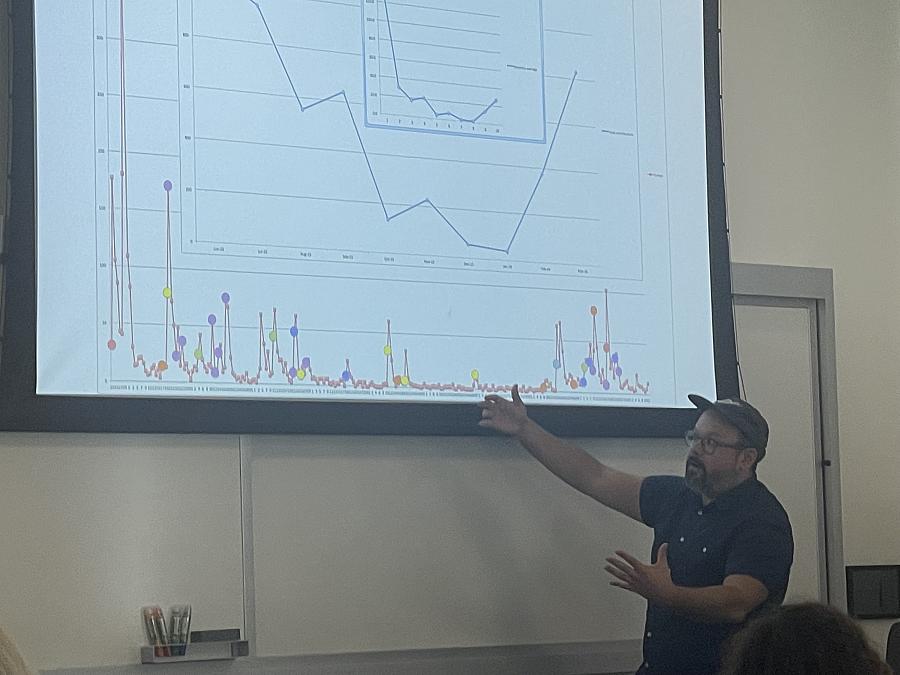How the most basic question in news coverage – who? – led to a multi-year project with community at the center

Terry Parris Jr. speaks at the Center for Health Journalism's 2023 National Fellowship week.
Apps Mandar Bichu
Early into the COVID-19 pandemic, Terry Parris Jr. wanted to know: Who was dying in New York City? The search for an answer led to a memorial project, called Missing Them, which was eventually projected onto the Brooklyn Bridge. The project’s impact and wide reach were possible only because of the relationships built with the community and innovative approaches to journalism.
Parris Jr. was the engagement director of nonprofit newsroom The City when New York City became an early epicenter for COVID-19 in April 2020. Now he is the Public Square editor of Headway, a New York Times initiative that is “exploring the world’s challenges through the lens of progress.” On Wednesday, July 19, he shared powerful examples of engagement journalism with the Center’s 2023 National Fellowship class.
Parris Jr. and his team began to track obituaries in April and May of 2020 to help fill in the gaps that early COVID-19 death data left blank. It quickly became apparent that of the hundreds of deaths reported each week, very few people were being memorialized. And due to the often high cost of paid obituaries, the people who were memorialized were often not representative of the communities hardest hit by COVID-19.
“Thousands and thousands and thousands of folks aren’t being remembered who died during COVID because they can't afford it. That's a problem. So we were thinking about ‘How could we make something? What could we do?’” Parris Jr. said.
So The City began crafting callouts to reach communities whose stories were going untold.
The journalists contacted funeral homes and local churches. They used Facebook groups, street fliers, support groups and community partners to get the word out. They collected stories through text messages, surveys and voicemails.
The result was a virtual memorial gallery that allowed people to share the stories of loved ones lost to COVID-19. The City also reported a series of stories that provided information about pandemic deaths and investigated concerns raised by those who participated in the project.
However, for Parris Jr., a digital memorial was not enough — he said he often thinks about how to put journalism in physical spaces, to allow people to not only read it but also experience it in an accessible and useful way.
“One of the things that we kept hearing from people was ‘We need a way to grieve.’ ‘How do we grieve?’ ‘A story is great but I want us to come together,’” Parris Jr. said.
The City was able to print out and create a memorial installation at Green-Wood Cemetery. The outlet also partnered with the Brooklyn Public Library to hold a three-day virtual event and created a five-act play that was performed virtually and eventually picked up by the Working Theater.
When the project first published, The City had collected and shared around 20 stories. The City has now collected and shared 600 stories and identified more than 3,000 people who died as a result of COVID-19 in New York. To honor them, New York officials turned to The City and its memorial project. The result: images of people who had died were projected onto the Brooklyn Bridge.
“It started with this idea, this question of: ‘Who's dying? Who's being impacted by this thing that's happening?’ A very basic journalism question,” Parris Jr. said. “We didn't know where it was going, but the reason it got here is because we were listening to the people who were talking to us, we were listening to what they needed, how they wanted a story, what they wanted out of it, and how they could participate.”
While engaged reporting can look different depending on the community, Parris Jr. said engagement can be broken down as “talking to relevant communities, serving them relevant and actionable information, and building relationships and — maybe, hopefully — trust.”

